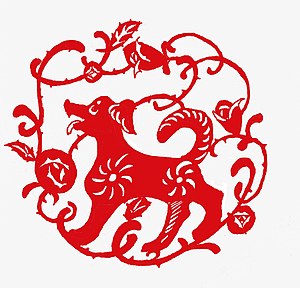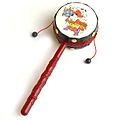Chinese folk art
This article needs additional citations for verification. (December 2009) |

Chinese folk art are artistic forms inherited from a regional or ethnic scene in China. Usually there are some variation between provinces. Individual folk arts have a long history, and many traditions are still practiced today. The general definition of folk art incorporates Chinese art forms that are not classified as Chinese fine art.
Chinese Folk art is the ancient forms of art that originated in China. Some of these ancient art forms include jade carvings, performance art such as music and their respective instruments, textile art such as basket weaving, paper art and clothing.
Jade Carving[]
Jade is a semi-rare green mineral. This mineral is prominently found in Chinese art. Due to the toughness of Jade, It is believed that Chinese Jade Carvings were first carved into weapons such as swords, it is unclear if the sword carvings were used for ceremonial or utilitarian use. As time went on Jade was carved into many different shapes and forms, an example of a Jade Carving is a circular disk which is usually used as a ritual function. By 3,000 BC Jade was referred to “yu” which means “the royal gem”. By 206 BC Xu Shen a Chinese Scholar during the Han Period listed the Five Virtues of Jade; they are: Benevolence, Honesty, Wisdom, Integrity, and Bravery. Unlike gold, diamonds, pearls Jade is considered priceless in China. Jade is extremely difficult to form hence why the mineral is so expensive. Jade is a precious gemstone that in the Chinese culture represents love, strength, purity, luck, and gentleness. Jade is also used in the ancient art of Feng Shui in China. Jade in the aspect of Feng Shui adds an element of harmony and balance to the space the jade is placed in. Carvings using jade was a common folk art in China. From objects such as masks to animals, jade - along with bamboo and wood - was used to craft many works of art. It is believed that Chinese Jade Carvings were first carved into weapons such as swords, it is unclear if the sword carvings were used for ceremonial or utilitarian use. As time went on Jade was carved into many different shapes and forms, an example of a Jade Carving is a circular disk which is usually used as a ritual function.
Basket weaving[]
Baskets are mainly woven with bamboo or plant stems.
Chinese kites[]
China is the birthplace of the kite, and Weifang is one of the chief places where Chinese kites originated. Kite-flying became prevalent in Weifang in the Song dynasty (960–1279). By the Ming dynasty (1368–1644) kite-flying had become even more popular, and kite fairs on a rather large scale had appeared. Kites were sold not only across Shandong, but also to Jiangsu, Fujian, Anhui and other places. The noted English scholar Joseph Needham listed kites in his book History of Science and Technology in China as one of the important contributions in science and technology that the Chinese introduced to Europe.[citation needed]
Food art[]
Sugar people[]
Sugar people (糖人) is a traditional Chinese form of folk art using hot, liquid sugar to create three-dimensional figures.

Sugar figures
Flour figures[]
Mian Ren (Flour Figure) are made of coloured flours. Craftsmen used to travel with their tools to villages and towns to make and sell flour figures for a very basic income. Sometimes flour figures are used in dishes together with vegetable carvings.
Paintings[]
Folk art paintings
Paper art[]
Chinese paper-cutting, or jianzhi, is a type of folk art that has roots in China during the 6th century and is attributed to Cai-Lun during the Han Dynasty. Chinese Paper art is known to be very intricate with the use of negative space. While this is used for mostly decorative reasons, paper art has been known to appear on mirrors, lanterns, walls, and much more. In most cities China Towns, paper art will adorn many street corners, business fronts, and inside buildings. The first two forms of paper art began in the Han dynasty with chinese paper cutting and chinese paper folding, including the hand fan and pinwheel (toy).
Performances[]
Puppetry[]
One of the oldest forms of folk art is puppetry. Puppeteers use various kinds of puppets, including marionettes, glove puppets, rod puppets, cloth puppets and wire puppets in performances incorporating folk songs and dances over some dialogues. The subject matter is derived mainly from children's stories and fables.
Shadow play[]
Chinese Shadow theatre is a form of puppetry that is performed by moving figures made of animal skins or cardboard held behind a screen lit by lamplight. The subject matter and singing style in shadow plays are closely related to Chinese opera, except without using live actors or actresses. Chinese Shadow theatre is a form of puppetry that is performed by moving figures made of animal skins or cardboard held behind a screen lit by lamplight. This Art style is passed down in a Master-Apprentice style until recently. The most common troupe roster is one puppeteer, singer and musicians who's subject matter and singing style in shadow plays are closely related to Chinese opera, except without using live actors or actresses. Shadow puppetry was banned by the government in 1966 during the cultural revolution, puppetry was allowed back in the late 1970s.
Chinese Shadow Play Figures, Two warriors; Qianlong era set; approx. 1780, Deutsches Ledermuseum, Offenbach, Germany
Textile arts[]
Chinese knot[]

Chinese knotting (中國結) is a decorative handicraft art that began as a form of Chinese folk art in the Tang and Song dynasty (960–1279 AD) in China. It was later popularized in the Ming. The art is also referred to as Chinese traditional decorative knots.[1] One of the more traditional art forms, it creates decorative knot patterns. During the Culture revolution it was not practiced, but nowadays it is very popular again.
In other cultures, it is known simply as "decorative knot".
Tiger-head shoes[]
Tiger-head shoes (虎头鞋) are an example of traditional Chinese folk handicraft used as footwear for children. Their name comes from the toe cap, which looks like the head of a tiger.
Musical instruments[]
Bolang gu, a traditional Chinese pellet drum and toy.
Muyu, a rounded woodblock carved in the shape of a fish, it is played by striking the top with a wooden stick; often used in Buddhist chanting.
See also[]
- Chinese art
- Chinese fine art
- Chinese games
- Culture of China
- Chinese folk art
References[]
- ^ Chang, 2006).
Bibliography[]
- Chang, Zonglin. Li, Xukui. (2006). Aspect of Chinese culture. 中国文化导读. 清华大学出版社 publishing
- Chinese folk art
- Arts in China






